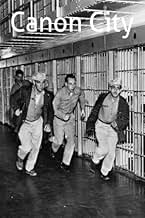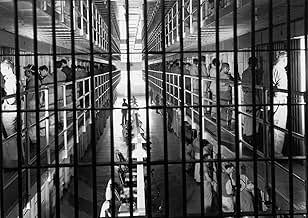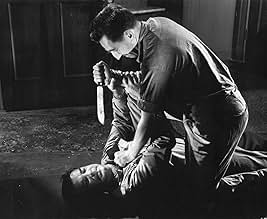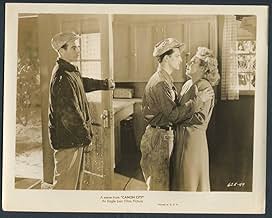IMDb-BEWERTUNG
6,5/10
472
IHRE BEWERTUNG
Füge eine Handlung in deiner Sprache hinzuTwelve inmates plan a prison break from the Colorado State Penitentiary but one of them reluctantly joins the group.Twelve inmates plan a prison break from the Colorado State Penitentiary but one of them reluctantly joins the group.Twelve inmates plan a prison break from the Colorado State Penitentiary but one of them reluctantly joins the group.
Reed Hadley
- Narrator
- (Synchronisation)
Empfohlene Bewertungen
Noirish docu-drama based on 1947 Colorado State Prison break.
The movie's best parts are the location shots in and around the Colorado State Pen. We get at least a flavor of prison routines and the small town atmosphere. At the same time, the chase sequence at the Royal Gorge provides a scenic, if fictionalized, passage. Then too, ace photographer Alton's studio recreation of the actual winter-time blizzard lends good noirish atmosphere. There's also some tension around convict Schwartzmiller's home invasion; otherwise, the movie's a pretty routine slice of thick ear.
To me, the screenplay surrounding the break and its aftermath seems muddled. Scenes follow in no particular developmental order. Characters are glimpsed and then dropped. It may be that writer Wilbur felt constrained by the film's factual basis and hurry-up schedule. After all, the movie wrap-up came only four months (January-May) after the breakout itself. (Contrast this rather disjointed narrative with the streamlined smoothness of the fictional, albeit thematically similar, Crashout {1955}.)
As a youngster growing up a few miles from Canon City, I still have a recollection of the hubbub surrounding the breakout. The name Sherbondi suddenly became a household alarm, though I'm not sure he was the sympathetic character of the screenplay. Guns abruptly sprouted across the Arkansas (river) Valley like deer season. Speaking of those memorable few days, I'm glad the movie re-creates the blizzard that certainly hampered the getaway. That rural part of the state seldom made Denver news, let alone national headlines. So it was a pretty big deal for us living there. (In passing--- Warden Roy Best, featured in the movie, later suffered big professional damage when his liberal use of a whipping post for unruly prisoners got statewide exposure.)
Choppy narrative and personal recollections aside, the film remains an interesting example of noirish docu-drama, which the results here strongly resemble.
The movie's best parts are the location shots in and around the Colorado State Pen. We get at least a flavor of prison routines and the small town atmosphere. At the same time, the chase sequence at the Royal Gorge provides a scenic, if fictionalized, passage. Then too, ace photographer Alton's studio recreation of the actual winter-time blizzard lends good noirish atmosphere. There's also some tension around convict Schwartzmiller's home invasion; otherwise, the movie's a pretty routine slice of thick ear.
To me, the screenplay surrounding the break and its aftermath seems muddled. Scenes follow in no particular developmental order. Characters are glimpsed and then dropped. It may be that writer Wilbur felt constrained by the film's factual basis and hurry-up schedule. After all, the movie wrap-up came only four months (January-May) after the breakout itself. (Contrast this rather disjointed narrative with the streamlined smoothness of the fictional, albeit thematically similar, Crashout {1955}.)
As a youngster growing up a few miles from Canon City, I still have a recollection of the hubbub surrounding the breakout. The name Sherbondi suddenly became a household alarm, though I'm not sure he was the sympathetic character of the screenplay. Guns abruptly sprouted across the Arkansas (river) Valley like deer season. Speaking of those memorable few days, I'm glad the movie re-creates the blizzard that certainly hampered the getaway. That rural part of the state seldom made Denver news, let alone national headlines. So it was a pretty big deal for us living there. (In passing--- Warden Roy Best, featured in the movie, later suffered big professional damage when his liberal use of a whipping post for unruly prisoners got statewide exposure.)
Choppy narrative and personal recollections aside, the film remains an interesting example of noirish docu-drama, which the results here strongly resemble.
I've lived in Canon City, Colorado for the last five years or so, and the experience of watching the film is a unique, slightly surreal one for me. Not only does the film take place in my tiny little town in the middle of nowhere, it takes place in MY NEIGHBORHOOD! The prison is a mere two blocks from my house, the movie theater three blocks, the Elk's Club where the prison guards eat in the film is right next door to the restaurant where I work. Seeing these familiar landmarks (as well as the fantastic shot of Main Street, which has aged little) gives me a small rush, and makes me inclined to declare CANON CITY an under-appreciated cult classic. Without the haze of nostalgia, I realize that the film, while certainly competent, is one of a series of mostly-forgotten B-pictures, focused on mostly by film nerds like me. I was actually quite impressed with the cinematography and lighting, which was surprisingly sophisticated and compelling, and the film rarely drags, but it just feels kinda same-y. Still, how cool is it that I'm still seeing movies in that old theater that's showing Abbott and Costello in 1948?
"Canon City" (spelled c-a-n-o-n but pronounced as "canyon") is an example of a type of film prominent in the late 1940s: the docudrama. Usually these films had a noirish sensibility and were almost always about gritty subject matter. They were part documentary and part fiction -- filmed on location in actual locales with objective third-party narration, stripped-down production values and a journalistic focus on presenting events matter-of-factly and without superfluous emotion.
"Canon City" tells the story of a famous prison break from a Colorado penitentiary. The first part of the film gives us a tour of the prison and introduces us to men who were the actual inmates at the time the movie was filmed; the chief warden of the prison likewise plays the warden in the movie. After this extended prologue, actors take over to portray the actual escape and the subsequent manhunt that put families living nearby at risk as the escaped cons used their homes as hideouts.
The film is very spare and terse, which is not a criticism from me. It's a refreshing break from the Hollywood melodrama that characterized glossier, studio-backed movies at the time. But the film is SO bare bones that it's difficult to feel strongly one way or the other about it. Its bargain-bin look is a nice compliment to the story it's telling, but one can't help but miss the style that artists who came with a higher price tag might have brought to the same material.
Grade: B
"Canon City" tells the story of a famous prison break from a Colorado penitentiary. The first part of the film gives us a tour of the prison and introduces us to men who were the actual inmates at the time the movie was filmed; the chief warden of the prison likewise plays the warden in the movie. After this extended prologue, actors take over to portray the actual escape and the subsequent manhunt that put families living nearby at risk as the escaped cons used their homes as hideouts.
The film is very spare and terse, which is not a criticism from me. It's a refreshing break from the Hollywood melodrama that characterized glossier, studio-backed movies at the time. But the film is SO bare bones that it's difficult to feel strongly one way or the other about it. Its bargain-bin look is a nice compliment to the story it's telling, but one can't help but miss the style that artists who came with a higher price tag might have brought to the same material.
Grade: B
Directed by veteran film-maker Crane Wilbur this rousing prison story is based on actual events that occurred at the Canon City penitentiary in Colorado in 1947.Newcomer Scott Brady is excellent as a convict who,caught up in events, must join in with eleven other escapees.As the fast-paced film-noir unfolds,each event is chronicled by that wonderful narrator Reed Hadley in semi-documentary fashion.A fine cast of character actors round out the cast; Jeff Corey as the ruthless convict leader,Stanley Clements,Robert Bice,and ( against type) Whit Bissell as a nervous killer.Actress Mabel Paige is particularly good as a very brave housewife.This film is another great example of Eagle-Lion pictures during that corporation's short run.
A fine prison break movie from Crane Wilbur by way of Eagle-Lion Pictures, Canon City is a very good, tense film, based on a true incident, about a group of men who break of of the eponymous state prison, where the movie was also filmed. There is particular emphasis on two escapees, a reluctant one who is basically a decent guy, and a more aggressive one, who isn't. As portrayed by Scott Brady and Jeff Corey these characters come to life and compel our interest, and in Brady's case sympathy.
As photographed by the masterful John Alton, the picture is a pleasure to watch, as Mr. Alton was a master of light and shadow, and is obviously in his element with this dark story. He brightens things up in the end with a snowstorm, which enables the picture to end on a grace note, and even a feeling of optimism, not wholly justified by the events we have just witnessed.
As photographed by the masterful John Alton, the picture is a pleasure to watch, as Mr. Alton was a master of light and shadow, and is obviously in his element with this dark story. He brightens things up in the end with a snowstorm, which enables the picture to end on a grace note, and even a feeling of optimism, not wholly justified by the events we have just witnessed.
Wusstest du schon
- WissenswertesFilm debut of Scott Brady.
- PatzerImmediately after the prison break, there's a shot of a crowd of people leaving a movie theatre, with Abbott & Costello in Strick am Hals (1948) (another Eagle-Lion release) prominently displayed on the readerboard. Only problem is, the break took place 30 December 1947, and The Noose Hangs High wasn't released until the end of the following April.
- VerbindungenReferenced in Let's Go to the Movies (1949)
Top-Auswahl
Melde dich zum Bewerten an und greife auf die Watchlist für personalisierte Empfehlungen zu.
Details
Box Office
- Budget
- 424.000 $ (geschätzt)
- Laufzeit1 Stunde 22 Minuten
- Farbe
- Seitenverhältnis
- 1.37 : 1
Zu dieser Seite beitragen
Bearbeitung vorschlagen oder fehlenden Inhalt hinzufügen


































